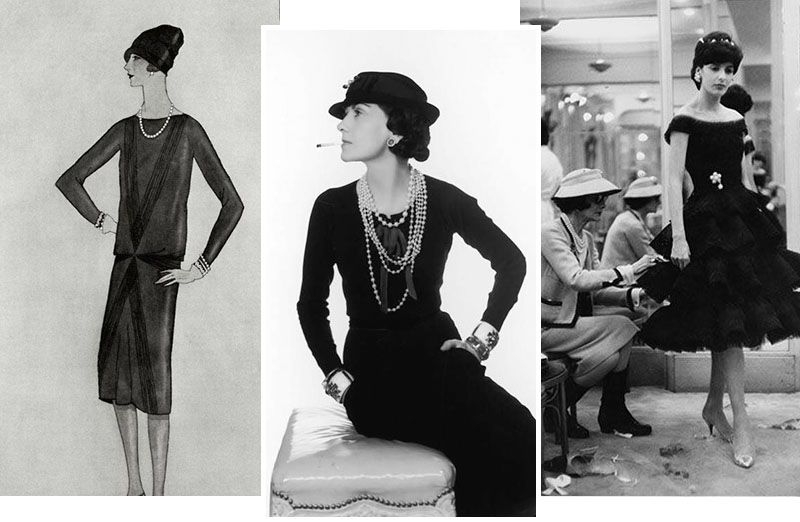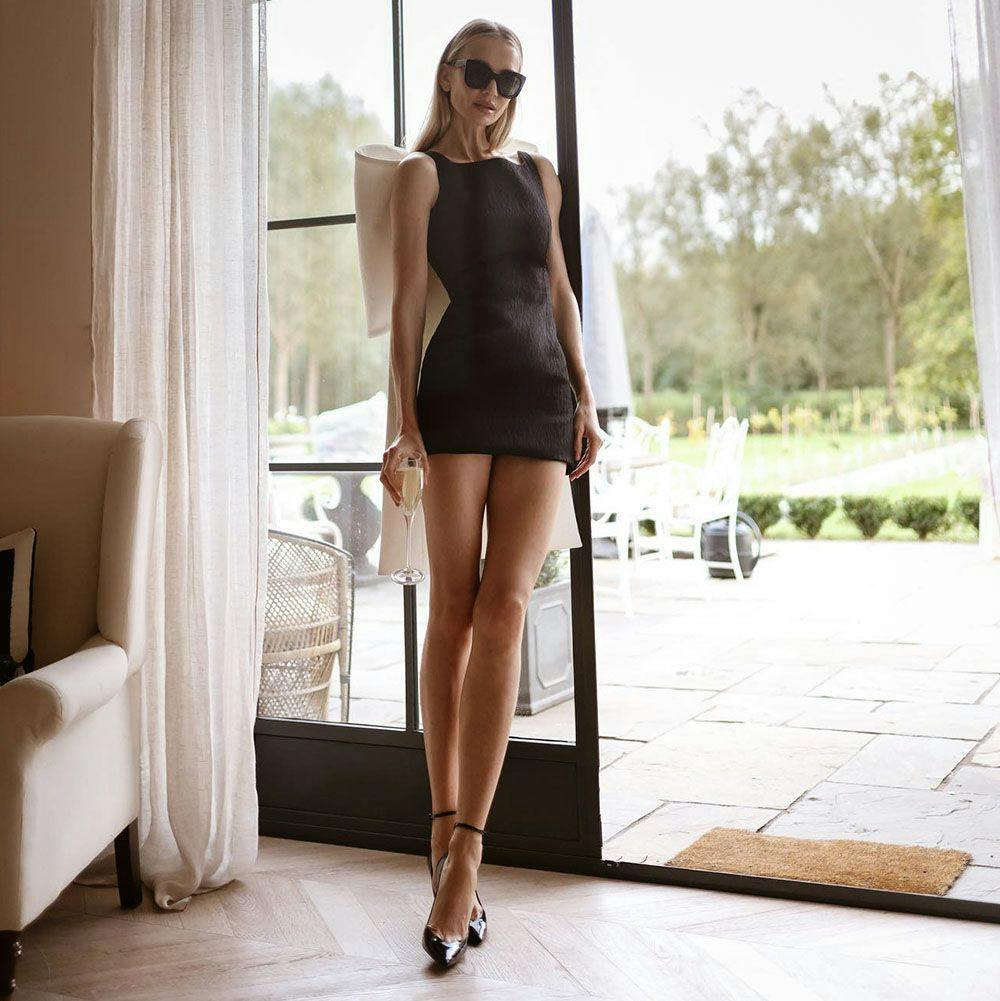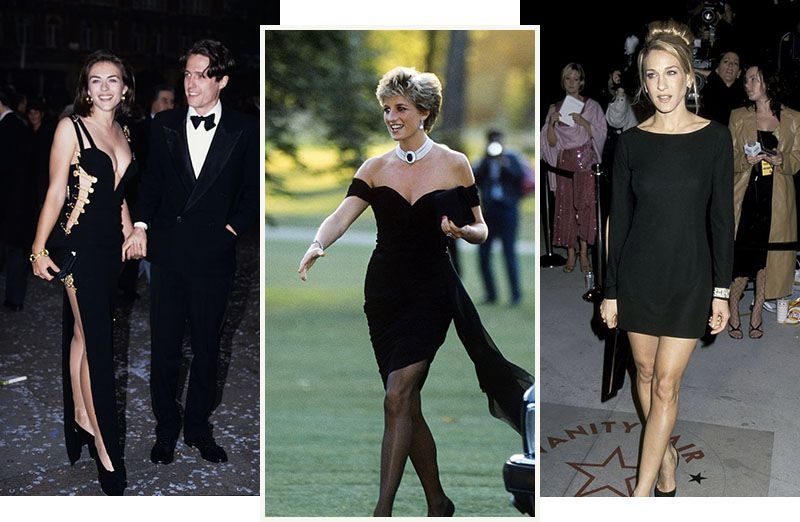
Tatiana Korsakova wearing the LBD
We have all heard that every woman should own a little black dress. It is, perhaps, one of the few fashion rules which is not subject to debate. A true classic that remains current at all times and on any occasion. It is hard to believe that its appearance in mid 1920s was such a revolutionary breakthrough for the world of fashion.
“Black is poetic. How do you imagine a poet? In a bright yellow jacket? Probably not,” designer Ann Demelmeister once said. This phrase is an accurate summary of the noble black colour. From times immemorial it has been attributed with qualities which symbolise darkness and mourning.
For a long time, clothes in this colour were only available to representatives of nobility because they were the only ones who could afford the pricey black dye. At last, thanks to the development of light manufacturing at the end of the 19th century, black colour made its way to the wardrobes of almost every stratum of society. Even then it was considered practical and elegant but never fashionable. We have Coco Chanel to thank for changing all that.
Chanel’s revolution
Coco Chanel was a true revolutionary in the world of fashion. The French designer was guided by the principle of luxurious simplicity and aimed to liberate women from the shackles of restrictive clothing. She allowed them to breathe by loosening tight corsets, created the first light hats by shedding traditional flower and feather ornaments and freed women’s hands by getting rid of reticule handbags and inventing the famous Chanel 2.55 bag.
At the beginning of the roaring 20s people celebrated the return to peaceful life, women gained increasingly more civil and social rights and fashion was too going through major changes. From this point on, when it came to outfits women preferred to combine luxury with comfort. They cut their hair short, wore trouser suits and chose straight silhouette dresses with a low waist. It was at this point, in 1926, that the American Vogue published the first sketch of Chanel’s black dress.
It had a circular neckline, long sleeves and just about covered the knees, which Coco considered the most unsightly part of a woman’s body. The editors of this glossy compared the couturier’s new creation to the then popular Ford Model T. They were convinced that soon the little black dress will become an inseparable part of every elegant woman’s wardrobe.
Fashion historians still debate as to what became the catalyst for creating this ascetic outfit. Many attribute the source of inspiration to the uniform of the orphanage where little Gabrielle grew up or to the dresses worn by the nuns who cared for them. Some link the appearance of the black dress with the death of Boy Capel, Coco’s lover. He died in a car accident in 1919 and Chanel was never able to publicly mourn, having never been married to him. At the time she proclaimed that she plans to submerge the whole world into a state of mourning for him by introducing the little black dress.
A dress for breakfast at Tiffany’s
It was not just Coco that contributed to the popularity of a black dress but also a number of other notable designers. Dior’s 1947 collection became an important stage in the history of this legendary item. As part of it, Christian Dior presented the so-called New Look silhouette with wasp-thin waists and fluffy skirts. As for the colours of these cocktail dresses, he chose pastel pink and black.
The rising popularity of colour films also had its role to play. As paradoxical as it might sound, the directors and costume designers often tried to dress their characters in black dresses because it was a colour that would not get distorted on film. In the early 60s, Audrey Hepburn became the leading celebrity and style icon. Holly Golightly, a fictional character played by her in Breakfast at Tiffany’s persuaded millions of women to want those cat-eye glasses and black dress.
The cult outfit was created especially for Audrey by Hubert de Givenchy. Floor length, with open arms and a distinctive cut-out décolleté at the back, the dress accentuated the actress’ petite figure and was yet another proof that true chic is to be found in simplicity.
From Hollywood to the royal chambers
The 90s forever sealed the little black dress in its cult status as the world had turned its attention to supermodels, Hollywood actresses and members of the royal family. Sara Jessica Parker, Wynona Ryder and Kate Moss praised minimalism and opted for no-nonsense short models. Caroline Bessette-Kennedy preferred modest midi dresses and Italian designers were working hard at using this purposefully humble item of clothing to reveal female sensuality.
In 1994 Elizabeth Hurley appeared on a red carpet in a long black Versace dress with a daring slit, fastened with stylised golden safety pins. This was how a young woman who was previously only known as Hugh Grant’s girlfriend became the talk of the town overnight. The provocative outfit was voted as one of Gianni Versace’s best creations and set the designers’ minds to using the red carpet as an extension of a cat walk to present their creations.
Princess Diana’s 1994 “revenge dress” gained legendary status with a photograph that was featured in media worldwide that year. Lady Di turned up to a charity evening in a black dress above the knee, with an asymmetric hem, open shoulders and a daring décolleté.
It was complemented with a chiffon plume, high heels and a bulky necklace. The look broke all royal protocols but carried a strong emotional message.
As the people’s princess arrived at the event, her husband Prince Charles was giving a candid interview on national television, admitting to years of marital infidelity. The Princess of Wales decided to not shun the cameras but instead face them in all her glory. She was initially planning to wear a Valentino dress which corresponded to the usual royal dress code. However, she went for this daring alternative by Christina Stambolian in the last moment. By then the black cocktail dress had been sitting in the back of the royal wardrobes for three years and this was its moment to shine.
How to choose a perfect LBD
There are countless types of little black dresses available today. It comes as midi or ultra short, free flowing or waist wrapping, covering or revealing a daring cleavage. To find the right dress for you, you need to analyse your figure and determine its type. This will help you choose the right cut which will highlight your good sides.
Women with wide shoulders and narrow hips should avoid dresses with a tightly covering top and opt instead for V-shaped cuts with a fluffy skirt. For those whose figure is more like a sphere or a square, it is best to pay attention to dresses with a lowered or heightened waistline. Curvy women need not dress in baggy garments. On the contrary, try wrapping dress models which accentuate your waist and reveal the collarbones or choose a universal model with a straight-line silhouette.
In any case, a little black dress should correspond to the requirements of your figure, taste and lifestyle. Do not go for sexy lingerie type combinations, if you do not feel comfortable wearing them. Equally, there is no need to buy a super trendy dress with lots of ruffles, if you tend to prefer minimalism. Choose a more universal model which will become the basis of many stylistic combinations, from an everyday outfit paired with a leather jacket and trainers to an evening look, complemented with sparkling jewellery.



